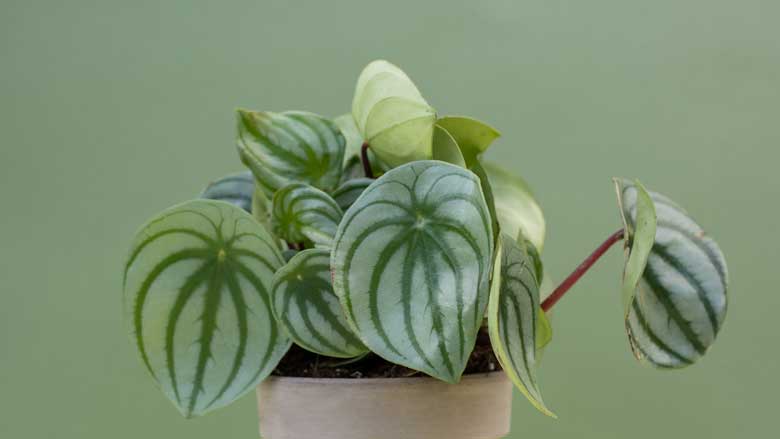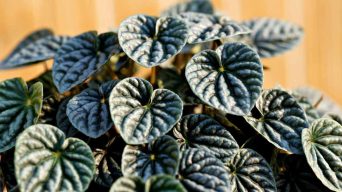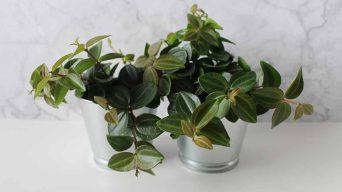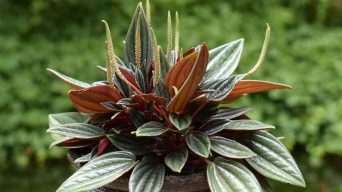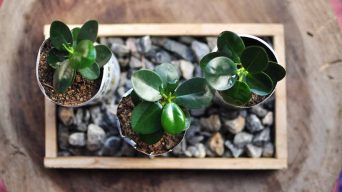If your Peperomia plants appear to be drooping, they may require some care and attention.re and attention.
They may have been doing well for a while, but suddenly they seem to be dragging themselves toward the ground.
What happened? Why are my Peperomia leaves drooping? Is there anything you can do about it?
There are a few reasons why your Peperomia might be drooping.
It could be due to overwatering or underwateringr, fertilizer burn, root rot, or even pests.
Don’t worry, though! In most cases, you can fix the problem and get your Peperomia back to looking healthy.
Here are ten possible causes of why your Peperomia leaves are drooping, along with what you can do about it:
Causes and Solutions for Peperomia Drooping Plant Leaves
1. Overwatering
Overwatering is a common problem for gardeners, especially those new to the hobby.
When plants are overwatered, their leaves can wilt and turn yellow.
This is because the roots cannot absorb all of the water, which causes the plant to become “waterlogged.”
The excess water also puts pressure on the plant’s stems and leaves, causing them to wilt.
In some cases, overwatered peperomia plants may even start to rot.
How To Fix It
If you think your Peperomia is being overwatered, the best thing to do is let the soil dry out completely before watering again. You can also try to water your plant less often.
Once you’ve corrected the watering schedule, you should see the foliage start to perk up within a few days.
2. Too Little Water
On the other hand, not watering your Peperomia enough can also cause droopy leaves.
This is because the plant isn’t getting the moisture it needs to stay healthy.
When a plant doesn’t have enough water, the leaves will start to wilt, curl, and turn brown.
The plant may also stop growing altogether.
Draught stress is a common problem in gardens, especially during the summer months.
How To Fix It
If you think your plant is underwatered, the best thing to do is to water it thoroughly.
Ensure the soil is moist all the way through and that the water is draining properly.
You can also try using a humidity tray to increase the moisture around your plant.
Underwatering is often the cause of the plant drooping leaves, so make sure you give your Peperomia enough water.
3. Low Humidity
Humidity is an important factor in the growth of many plants, and the Peperomia is no exception.
These plants originate from tropical rainforests, where they are accustomed to high humidity levels.
In lower-humidity environments, the leaves of Peperomia will begin drooping as they lose moisture to compensate for the lack of humidity.
This is a survival mechanism, as drooping leaves help the plant reduce evaporation and conserve water.
However, it can also be detrimental to the plant’s overall health, as the leaves cannot photosynthesize properly when they are drooping.
As a result, it is important to maintain high humidity levels around Pepetromia plants, especially during dry periods.
By doing so, you can help these plants to stay healthy and prevent the foliage from drooping.
How To Fix It
There are a few ways to increase the humidity around your Peperomia.
One way is to use a humidifier, which will add moisture to the air and help the plant to stay hydrated.
Another way is to place the plant on a humidity tray, which is a shallow dish filled with water and pebbles.
The water will evaporate and increase the humidity around the plant.
You can also mist the leaves of your Peperomia regularly to keep them hydrated.
By increasing the humidity, you can help to prevent the leaves from drooping.
4. Not Enough Light
Peperomia plants are known for their attractive, textured leaves, which come in various colors and shapes.
However, these plants are also relatively sensitive to changes in light levels.
If a Peperomia plant does not receive enough lighting, it may start to look droopy.
This is because the plant cannot produce enough chlorophyll, which is necessary for photosynthesis.
As a result, the plant cannot generate its energy to maintain its growth and health.
While these plants can survive in low-light conditions, they will thrive if given enough bright indirect light.
How To Fix It
If you think your Peperomia is not getting enough light, the best thing to do is move it to a brighter location.
Ensure the plant receives indirect sunlight for at least part of the day.
When grown as an indoor plant, Peperomia do best near a south- or west-facing window, where they will receive plenty of light.
If you cannot provide enough light for your Peperomia, you may need to supplement its light with artificial grow lights.
By increasing the light levels, you can help the plant produce more chlorophyll and prevent droopy Peperomia plants.
5. Fertilizer Burn
Peperomia plants may be drooping due to fertilizer burn for a few reasons.
First, if the plant is receiving too much fertilizer, the roots can become overwhelmed and unable to absorb all nutrients.
This can cause the leaves to appear wilted or burned.
Second, if the fertilizer is not diluted properly, it can build up in the potting soil and burn the roots.
Finally, if the fertilizer contains too much salt, it can also cause leaf burn.
Plants need to be fertilized regularly, but it is important to do so carefully to avoid leaf burn.
Fertilize every two weeks during the spring and summer with half-strength diluted fertilizer.
How To Fix It
If you think your Peperomia has fertilizer burn, the best thing to do is flush the soil with water.
This will help to remove any excess fertilizer from the roots and prevent further damage.
When fertilizing your Peperomia, it is important to use a diluted fertilizer.
This will help prevent the roots from becoming overwhelmed and ensure that the plant receives the right amount of nutrients.
It is also important to make sure that the fertilizer you use does not contain too much salt, as this can cause leaf burn.
By using a diluted fertilizer, you can help prevent leaf burn and keep your Peperomia houseplants healthy.
6. Plant Root Rot
One of the most common problems that Peperomia owners face is root rot.
This can be caused by several factors, including overwatering, poor drainage, or compacted soil.
When Peperomia plant are damaged by root rot, they cannot absorb water and nutrients from the soil.
As a result, the plant may exhibit drooping leaves and yellowing, and in severe cases, it may even die.
Root rot is a serious problem, but it can be prevented by taking care to water the plant properly and keeping the roots healthy.
How To Fix It
If you think your Peperomia has root rot, the best solution is to remove the plant from the pot and inspect the root system.
If they are black or mushy, they are likely to be rotting. Cutaway any affected roots and repot the plant in fresh, well-draining potting mix.
When watering your Peperomia, it is important to allow the soil to dry out between waterings.
This will help prevent the roots from becoming waterlogged and prevent root rot.
It is also essential to ensure that the pot has good drainage so that excess water can drain away from the roots.
7. Pest Infestation
One of the most common problems that affect houseplants is pest infestation.
Aphids, mealybugs, spider mites, and whiteflies are all attracted to the plant and can cause droopy leaves.
The pests feed on the plant sap, which disrupts the flow of nutrients and water.
This can cause the Peperomia leaves to turn yellow
or brown and eventually drop off.
In severe cases, the entire plant may die.
Pest infestation is a serious problem, but it can be prevented by taking measures to control the pests.
How To Fix It
If you think your Peperomia has been infested with pests, the best thing to do is to remove the plant from the pot and inspect it carefully.
If you see any bugs or eggs on the plant, you will need to treat it with neem oil or insecticidal soap.
When treating your Peperomia for pests, using a safe and effective product is important.
Neem oil is a natural pesticide that is safe for humans and animals but will kill the pests infesting your plant.
Insecticidal soap is another safe and effective option for treating pest infestations.
8. Temperature Stress
Peperomias are native to tropical and sub-tropical regions and are accustomed to warm, humid climates.
When exposed to cooler temperatures, their stems and leaves will begin drooping in an effort to reduce transpiration and prevent moisture loss.
The ideal temperature range for these plants is between 65 and 75 degrees Fahrenheit, and they should be kept out of direct sunlight to prevent leaf scorching.
If the temperature drops below 50 degrees Fahrenheit, the plant will go into dormancy, and the peperomia leaves will fall off.
On the other hand, when plants are exposed to excessively high temperatures, their leaves will also droop in an effort to prevent moisture loss.
If the temperature rises above 90 degrees Fahrenheit, the plant will experience heat stress.
The leaves will turn yellow or brown and eventually fall off.
How To Fix It
If your Peperomia is experiencing temperature stress, the best thing to do is to move it to a location where it will be protected from extreme temperatures.
If the plant is too cold, move it to a warmer location out of direct sunlight. I
f the plant is too hot, move it to a cooler location out of direct sunlight.
The ideal temperature range for Peperomias is between 65 and 75 degrees Fahrenheit, so try to keep the plant in this range.
9. Transplant Shock
Peperomia is a hardy houseplant that can tolerate a wide range of growing conditions.
However, even this tough plant can be susceptible to transplant shock.
One of the most common symptoms of transplant shock is drooping leaves.
This is caused by a disruption in the plant’s root system, preventing it from efficiently taking up water and nutrients.
As a result, the leaves start to wilt and turn yellow or brown. In severe cases, the entire plant may die.
How To Fix It
If your Peperomia is experiencing transplant shock, the best thing to do is give it time to recover.
Transplant shock can be a stressful experience for a plant, so it will need some time to adjust to its new environment.
It is important to keep the plant well-watered and out of direct sunlight during this time.
Once the plant has recovered from transplant shock, it should return to its normal growth pattern.
10. Nutrient Deficiencies
Peperomias droop due to nutrient deficiencies for several reasons.
First, when a plant lacks nutrients, it cannot produce the energy to maintain its structure.
This can cause drooping Peperomia leaves as the plant struggles to support its own weight.
Second, nutrient deficiencies can cause dehydration, as the plant cannot efficiently absorb water from the soil. This can also lead to droopy leaves, wilting, and discoloration.
Finally, nutrient deficiencies can cause stress to the plant, manifesting in the form of drooping leaves.
When a plant is under stress, it produces hormones that signal the leaves to drop to conserve energy.
How To Fix It
If your Peperomia is experiencing nutrient deficiencies, the best thing to do is fertilize it.
Use a balanced fertilizer high in nitrogen, phosphorus, and potassium.
Fertilize the plant every two weeks during the growing season.
This will provide the plant with the necessary nutrients to recover from its deficiency and return to its normal growth pattern.
You can also supplement the fertilizer with compost or manure to provide the plant with additional nutrients.
Add a layer of compost or manure around the base of the plant, and water it thoroughly.
This will help improve the soil’s quality and provide the plant with the nutrients it needs to thrive.
How to Prevent Peperomia Drooping
Preventing peperomia leaves from drooping requires proper care and attention to the plant’s needs. Here are some steps you can take to prevent peperomia drooping:
- Watering: Overwatering is a common cause of peperomia leaf drooping. Ensure you allow the top inch or so of the soil to dry out before watering again. Always use well-draining soil and pots with drainage holes to prevent waterlogged roots.
- Light: Peperomias prefer bright, indirect light. Place your plant in a location where it receives filtered sunlight or artificial light. Avoid direct sunlight, which can scorch the leaves and cause them to droop.
- Humidity: Peperomias thrive in moderate to high humidity levels. To prevent drooping, mist the leaves regularly or place a tray of water near the plant to increase humidity.
- Temperature: Maintain a consistent room temperature for your peperomia. They do well in temperatures between 65-75°F (18-24°C) and should be protected from drafts and sudden temperature fluctuations.
- Fertilizing: Fertilize your peperomia sparingly during the growing season (spring and summer) with a balanced, diluted, liquid fertilizer. Avoid over-fertilizing, as excessive nutrients can harm the plant.
- Potting Mix: Ensure your peperomia is planted in well-draining soil. A mix of potting soil and perlite or sand works well to prevent water retention.
- Pot Size: Choose an appropriately sized pot for your peperomia. A pot that is too large can hold excess moisture, leading to root rot and drooping leaves.
- Pruning: Regularly trim and prune your peperomia to encourage healthy growth and maintain its shape. This can help prevent the plant from becoming top-heavy and drooping.
- Pest Control: Keep an eye out for pests like spider mites and mealybugs, which can weaken the plant and cause drooping leaves. If you notice any infestations, take steps to remove them promptly.
- Repotting: Peperomias generally do not require frequent repotting. Repot only when the plant becomes root-bound or outgrows its container.
By following these care tips and adjusting them based on the specific needs of your peperomia variety, you can help prevent drooping leaves and keep your plant healthy and thriving.
Remember that consistent and attentive care is key to maintaining the well-being of your peperomia.
Final Thoughts About Drooping Peperomia Foliage
There are several reasons why Peperomias may start drooping.
The most common causes are underwatering, overwatering, temperature stress, transplant shock, and nutrient deficiencies.
If your Peperomia houseplants are drooping, the best thing to do is identify the cause and take steps to correct it.
Your Peperomia will recover from its problem and return to its normal growth pattern with proper care and attention.

